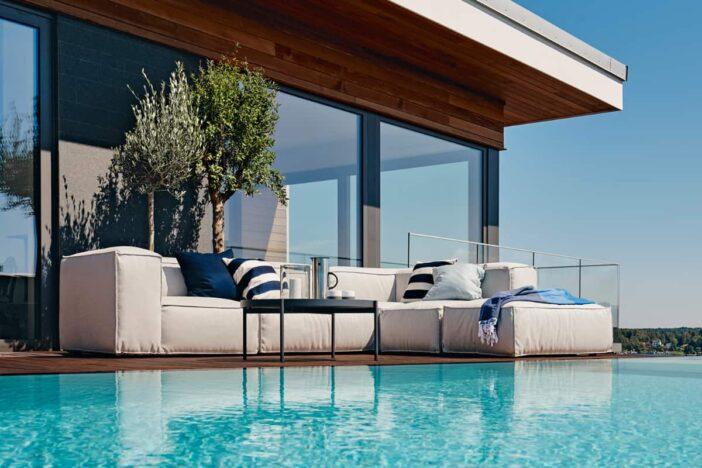
What is the best material for outdoor furniture?
When evaluating outdoor furniture, you’re probably going to look for many of the same characteristics that you value in indoor tables, chairs and sofas – durability, comfort and style (and of course price). The primary difference, however, is that patio furniture has to endure exposure to the weather outside. While there is virtually no patio furniture that’s 100% weatherproof, there are big differences based on the materials used.
You are watching: Outdoor Furniture Materials Guide – 2023 Update
Before you decide, it’s important to understand the strengths and weaknesses of various material options. Determine how well each aligns with the requirements of your residential or commercial environment, as well as your personal preferences and priorities. Choosing the “best” material for outdoor patio furniture is dependent on matching your specific needs with the inherent qualities of each substance since each situation is unique.
Materials for Outdoor Furniture Frames & Tabletops
Wood
Wood has been a popular raw material for furniture for millennia. It has a natural beauty, is generally easy to work with and provides a sturdy framework for tables, chairs, benches and other furnishings. However, not all woods are created equal when it comes to outdoor usage. Many softwoods, such as pressure-treated pine, cedar and fir are inexpensive and widely used for indoor furnishings, but do not stand up well to the elements and need constant protection when not in use. Hardwoods, on the other hand, are much heartier, resist weather damage and can last decades if treated properly. On the downside, they are often more difficult to shape and are typically more expensive than softwoods. But, there are major differences between hardwoods too.
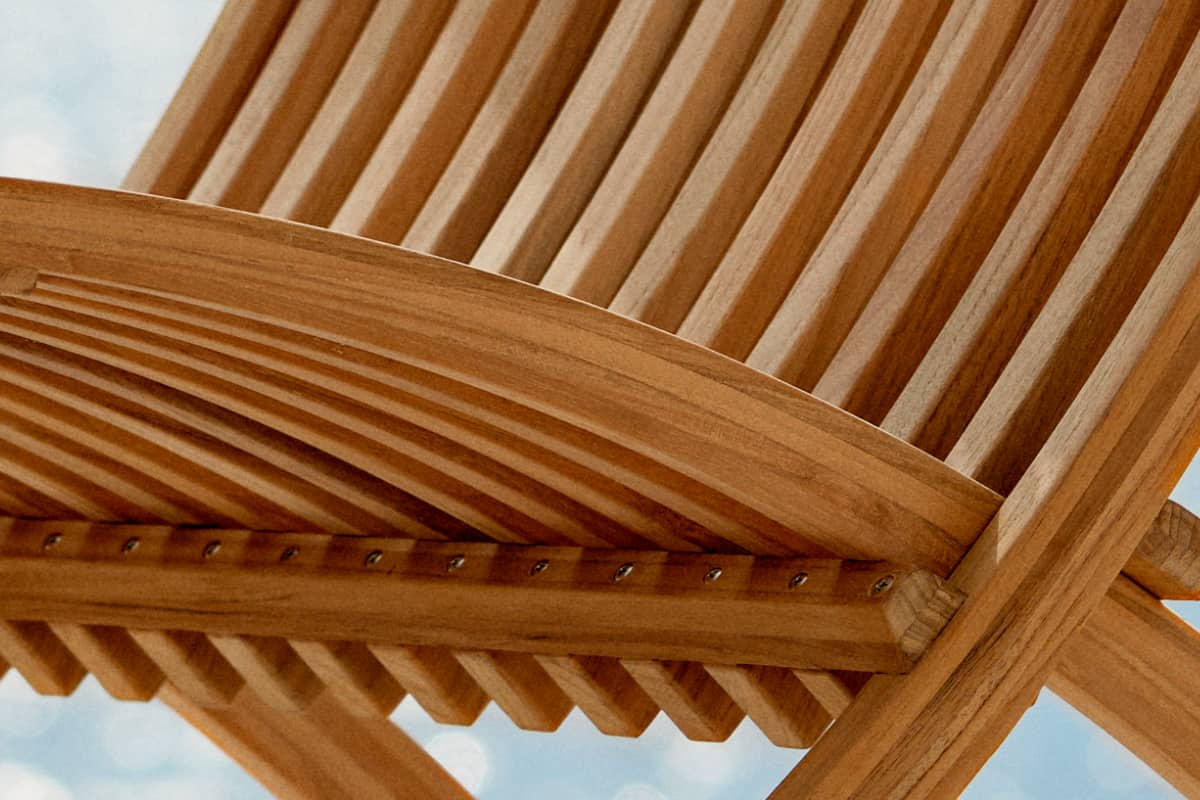
Teak
Teak is easily the most popular wood choice for outdoor furniture. Its high demand, coupled with limited availability, has pushed the price of this fine-grained hardwood extremely high. Fortunately, teak has many characteristics that make it ideally suited for outdoor use. It is incredibly strong and doesn’t warp, crack or become brittle like many kinds of wood. This is because teak repels most water and does not expand or contract in the drying process. It has a high natural oil content, which makes it highly resistant to damage from rot, decay and insects. This durability against the elements enables teak to last the longest – up to fifty years! Its gorgeous honey brown appearance can be maintained with minimal oiling, or it can patina into an attractive silver-gray over time, if left untreated. Most patio furniture brands have at least a few pieces made from this handsome wood. Scandinavian manufacturers like Skagerak and Skargaarden embrace teak’s natural beauty and utilize its inherent strength to design artistic graceful collections of outdoor lounge and dining furniture. It’s relatively easy to care for and can be cleaned with mild soap and water.
- PROS – Durable, strong, resistant to weather, decay and insects, no cracking or warping and it’s easy to care for
- CONS – High price
Shorea
This reddish-gold Southeast Asian material is one of the few hardwoods that is stronger and heavier than teak. Exposure to heat actually improves its strength (modus of rupture) and flexibility (modus of elasticity) [Noh & Ahmad 2017]. Harvesting shorea (a.k.a. meranti) is highly regulated to ensure that it is sustainable, like many of the other hardwoods used for outdoor furniture. It also has a high oil content that protects it against insects, minimizes rotting and resists weather damage. Like teak, shorea becomes a silver-gray patina if it is not oiled regularly and lasts up to fifty years. However, it has a much lower price. The only major drawback for shorea is that, due in part to public unfamiliarity, few retailers sell it.
- PROS – Strength, weather and insect resistant, eco-friendly and cost-effective versus teak
- CONS – Limited commercial availability
Eucalyptus
This strong Australian hardwood is fast-growing, lasts a long time and offers significant cost savings versus teak. Its natural washed appearance has a rustic appeal, which will develop into a silver patina unless oiled regularly. It is weather and rot resistant and its oil acts as a natural insecticide. But, a sealant is recommended to improve the resistance of eucalyptus to pests and minimize the negative impact of uneven moisture retention.
- PROS – Durable, insect and rot-resistant, eco-friendly sustainable growth and cost-effective
- CONS – Susceptible to marine and pinhole borers and vulnerable to cracking if untreated with a sealant
Ipe
Central and South American ipe (a.k.a. ironwood), unlike many of its hardwood counterparts, has a deep rich colored grain which fades slower when exposed to weathering [Jankowska, Reder, Gołofit 2017]. It has a high natural oil content, which helps it resist insects, decomposition and various forms of fungi. Its hard, dense structure fortifies it against physical damage such a denting, warping and cracking. Though it can last up to forty years, ipe requires much preparation when cut and glued together.
- PROS – Durable, strong and resistant to pests and fungi
- CONS – Difficult to work with
White Oak
This abundant wood is stronger and harder than most and lasts for decades. It has long been used to build boats, due to its structural ability to repel water, which also helps it resist rot. However, it doesn’t possess much natural oil and needs paint or a sealant to retain its durability. Over time, untreated white oak develops an attractive gray patina.
- PROS – Water-proof, rot-resistant and strong
- CONS – Low oil content
Other Hardwoods
There are a number of other hardwoods that share some of the positive qualities of teak at a much lower price point. However, they also have drawbacks relative to the hardwoods mentioned above. Reddish-brown acacia (a.k.a. locust) is readily available but is more likely to warp or crack than shorea or eucalyptus. Roble is scarce, lightweight and lasts half as long as teak, while African iroko is very hard to work with, easily splinters and blunts woodworking tools. Mahogany has a beautiful reddish tint, but is coarse, requires a lot of maintenance and doesn’t handle rot as well as teak.
Metal
Metal is typically the strongest and most durable material for outdoor garden furniture. Because of its strength, metallic frames can be thinner and shaped into more complex designs than other options, giving manufacturers greater style flexibility. Metal is also a great choice when used in combination with other materials that have their own functional and aesthetic benefits. Various production techniques can create metal chairs and tables that don’t require bolts, screws or other fasteners that make other types of furniture more susceptible to break down. However, metal has its drawbacks as well. It heats up in the sun, making it uncomfortable to touch. Certain metals are very heavy and hard to move, while all metals are vulnerable to rust and corrosion to some degree. But each type metal has its own unique set of characteristics.
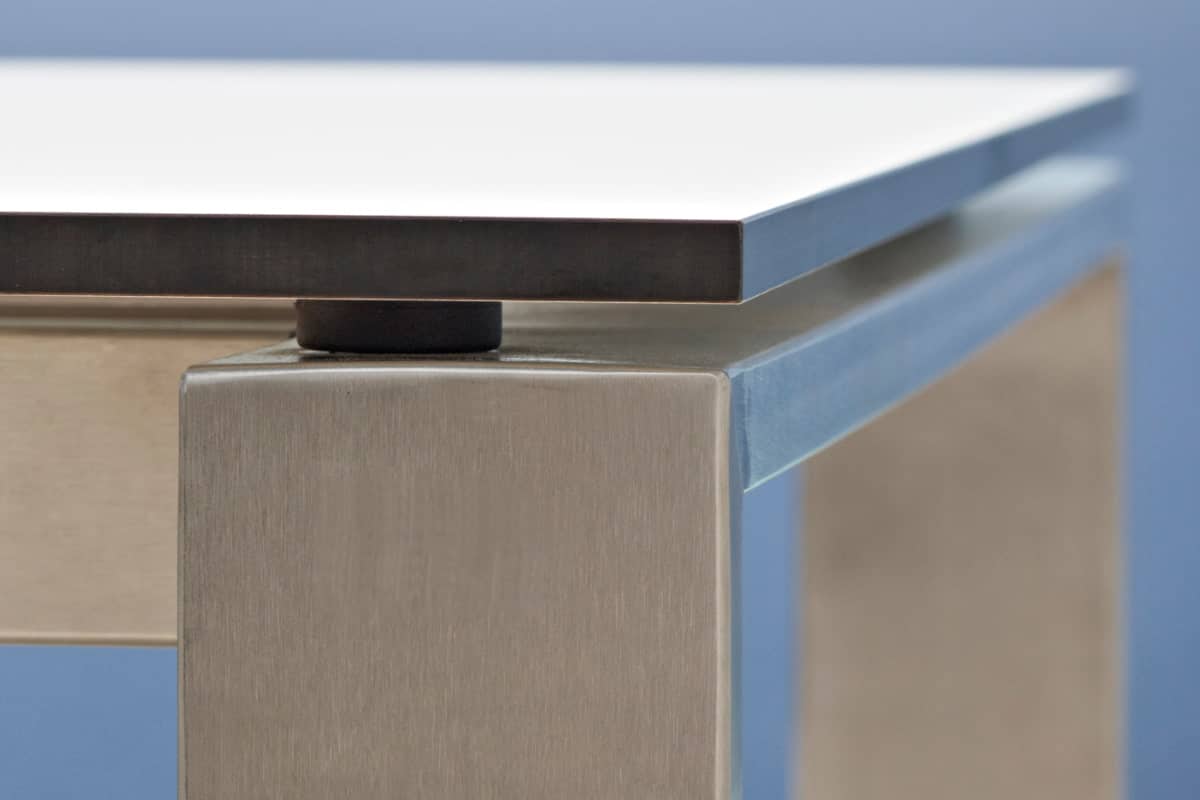
Stainless Steel
This sturdy metal alloy is extremely strong, which makes it a great material option for large weight-bearing outdoor dining tables, sofas and sectionals. Its high density helps prevent dents and other damage from frequent use. While it does get hot to the touch when exposed to the summer heat, stainless steel endures extreme temperatures better than most metals. Its composition makes it virtually immune to rust and corrosion, but a powder coating is recommended for added resistance, especially in coastal areas where salt air and water are present. If you are comparing types of stainless steel, the higher the Chromium content the more resistant the alloy is to atmospheric corrosion. Similarly, the presence of Molybdenum prevents red rust and reduces the depth of surface pitting [Mameng, Pettersson & Leygraf 2017].
Garden and patio furniture made from stainless steel is heavy and will not tip over or blow away under windy conditions. It’s a great material choice for high end modern outdoor furniture since its sleek silvery metallic finish has a chic contemporary look. Though it’s expensive, stainless steel is worth every penny. Not only is it relatively easy to clean, but it’s often made using recycled metals, making it an environmentally responsible choice.
- PROS – Durable, strong, resists rust, wind-resistant and easy to clean
- CONS – Expensive and retains heat
Aluminum
Aluminum is the most popular metal for outdoor furniture. Despite its lightweight, it is strong, durable and can easily be worked into a variety of intricate shapes. Aluminum is relatively inexpensive, low maintenance and never rusts. Although it is highly weather-resistant on its own, a polyester powder coating is recommended. This electrostatic process not only increases protection against the elements and scratching, but it also allows you to added color to the mix. While you can buy painted aluminum, powder coating adheres better to the metal and is much more resistant to fading. This is also helpful if your deck or poolside is exposed to salt air, which tends to eat away at paint and untreated metal. Like other metals, aluminum heats up, so it’s best to have seat cushions to keep you cool and comfy.
- PROS – Strong, lightweight, weather-resistant, inexpensive and low maintenance
- CONS – Hollow tube frames may blow over in high winds and it retains heat
Wrought Iron
Throughout history, iron has been used for tools, buildings and furnishings because of its strength and durability – it can last a hundred years if properly cared for. It’s among the heaviest of metals, which makes it difficult to move wrought or cast iron furniture. However, it certainly won’t blow over in the wind. It is extremely malleable when heated and hammered into shape. This allows wrought iron to form ornate hand-crafted designs with an upscale artisan feel. Cast iron, on the other hand, is melted and poured into molds, but it’s heavier and harder to manage than wrought iron.
Read more : Top 4 Brands Offering Free Online IP Camera Cloud Storage
While it is long-lasting, outdoor iron frames and tabletops can require a lot of care to clean, maintain and protect against rusting. Fortunately, the best contemporary wrought iron is treated with weather-resistant finishes to seal out damaging moisture. Additionally, the metal tends to match the prevailing temperature – it gets very hot in summer and freezing cold if left out in the winter. Wrought iron outdoor furniture is hard and can be uncomfortable without upholstery to cushion seat and backrests.
- PROS – Durable, solid, stylish classic look and great for windy areas
- CONS – Rusts easily, requires more maintenance, can be uncomfortable, difficult to move and retains heat or cold
Resin & Plastic
Man-made synthetic materials, such as resin and plastic, are becoming more and more prevalent in the world of outdoor furniture. New manufacturing processes and hybrid compositions enable these polymers to take on shapes and sizes previously unattainable. Synthetics are typically lightweight, inexpensive and can be molded into any decor style imaginable. Because color is inherent in the chemical make-up, they are fade-resistant and don’t require paint or sealants used by other materials. They’re also a breeze to clean and maintain. There is a growing number of plastics and resins, but here are a few of the more common ones currently in use.
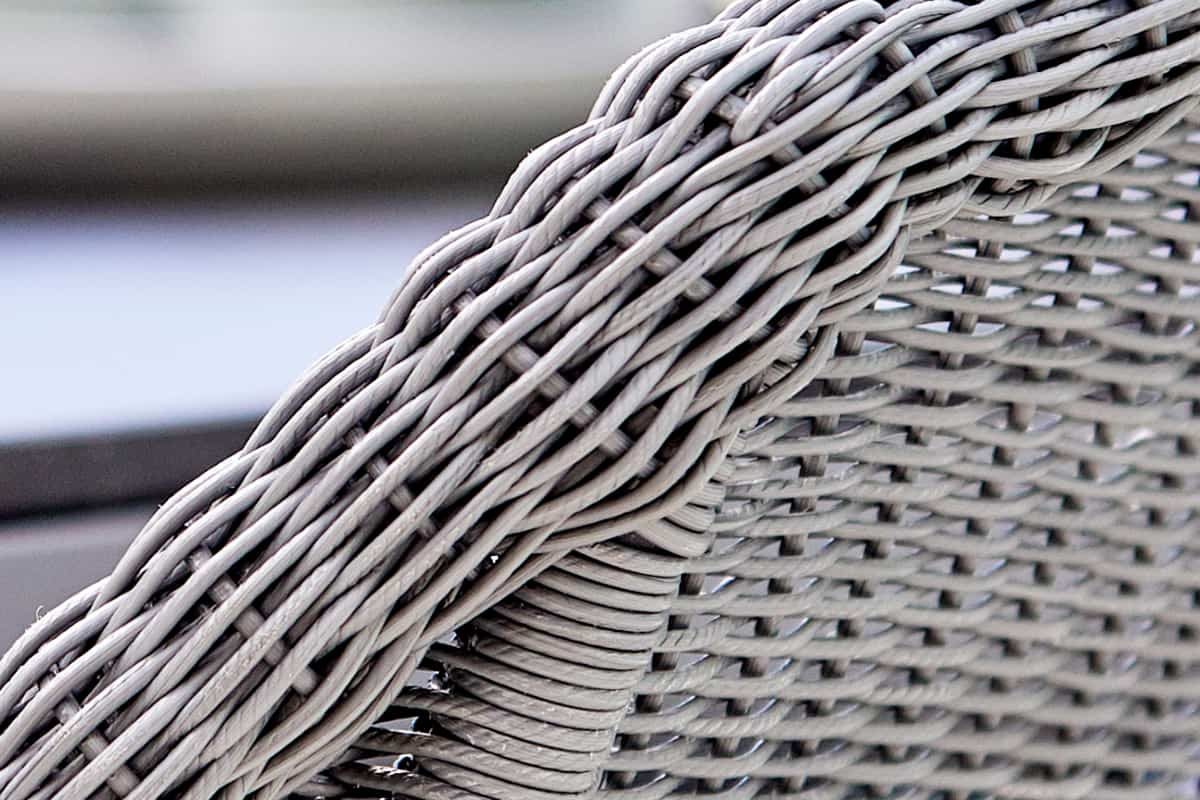
Synthetic Resin – All-Weather Wicker
Virtually all outdoor wicker furniture is made from synthetic polyethylene resin. Natural wicker is made from a variety of organic sources such as rattan, seagrass, bamboo, banana leaf and even willow. While strong and aesthetically pleasing, plant-based wicker is susceptible to damage from rainy weather, moisture and humidity – a poor material choice for outdoor chairs, sofas and coffee tables.
High-quality resin is very dense, resistant to weather damage and eco-friendly. High-density polyethylene (HDPE) does not emit any chemicals, is highly puncture resistant and can be exposed to UV rays for decades without experiencing any degradation [Topliff 2018]. Synthetic all-weather wicker is also strong, lightweight, fade-resistant and easy to clean. There are lower-quality synthetic wickers made from polyvinyl chloride (PVC), which tends to become brittle and crack over time. Most outdoor wicker patio furniture is constructed over an aluminum frame, which increases the weight it can support. Synthetic wicker can be colored an organic shade, making it virtually indistinguishable from natural wicker. It can also be given a vibrant tone that adds a pop of color to your lanai or hardwood deck.
- PROS – Extremely weather-resistant, easy to clean, can look like natural wicker and HDPE wicker is 100% recyclable
- CONS – Not heavy enough for many windy environments
Recycled Plastic
Eco-friendly recycled plastic (i.e. made from milk cartons, shampoo bottles, etc.) is a great option for stylish outdoor patio furniture. It’s extraordinarily strong, durable and resistant to moisture, mildew, insects and saltwater. It can be heavier than other plastic materials but is still susceptible to high winds. Recycled plastic doesn’t peel, crack or require much maintenance. It is stain-resistant and cleans easily with soap and water.
- PROS – Strong, weather and fade resistant, easy to clean and “green”
- CONS – May be too light for extremely windy conditions
Other Plastics
Polyethylene (PE) is the most common form of plastic used to make deck furniture. It’s cost-effective, but the high-density version (HDPE) is required for outdoor applications since it is far more durable and weather resistant. Polypropylene (PP) is lighter weight and highly resistant to chemical degradation and heat. Polycarbonate (PC) is a very tough material that is impact-resistant, although it is susceptible to scratching. It’s the preferred choice of plastic when transparency is desired. Acrylic – Polymethyl Methacrylate (PMMA) is similar to polycarbonate in that it is clear. However, this less expensive alternative is not as strong and is vulnerable to cracking.
Miscellaneous Outside Furniture Materials
In addition to wood, metal and plastic, luxury outdoor furniture utilizes a number of other durable materials in a variety of applications. Patio dining tables, for example, may have metallic or wooden frames with a tabletop made from another material. These substances have different qualities that are appropriate for specific functional and aesthetic requirements.
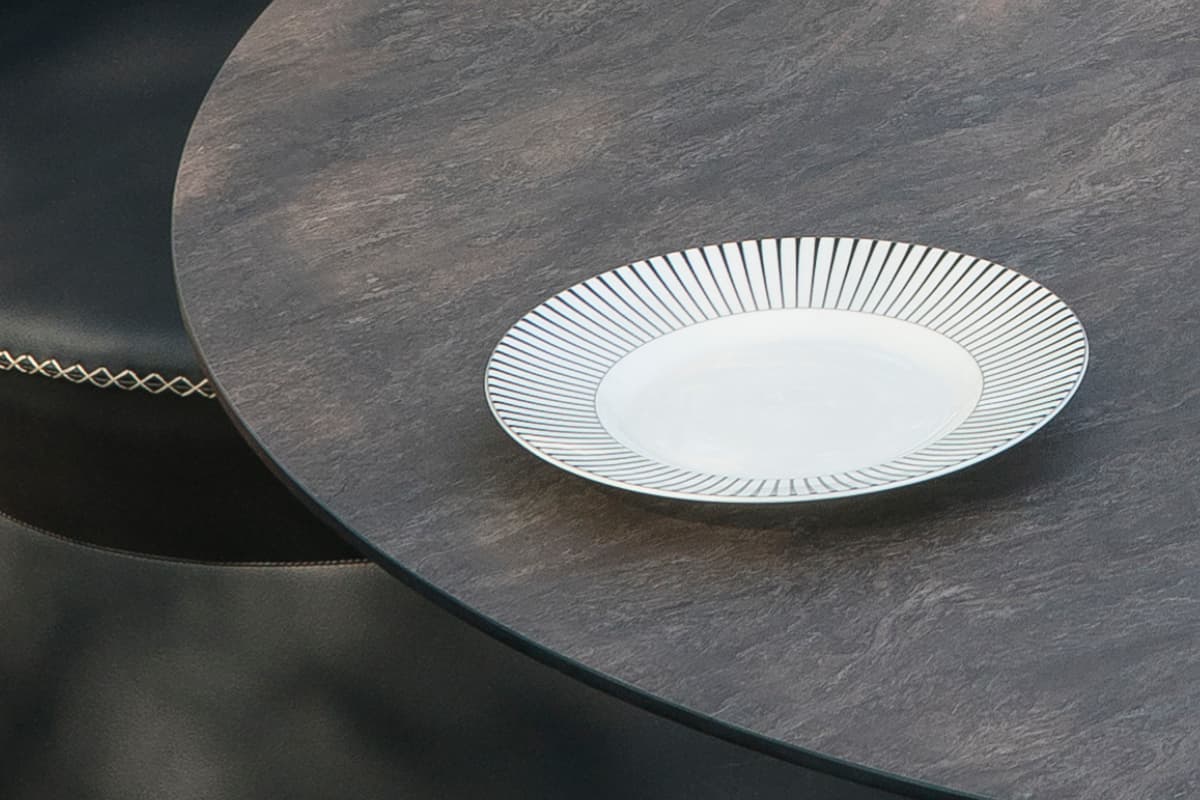
High Pressure Laminate (HPL)
This composite is usually comprised of kraft paper that is impregnated with resin and aluminum and then heated under high pressure to create a layered contemporary material. HPL has a sleek look and is extremely hard, helping it resist stains and scratches. Melamine can be added to increase this laminate’s durability. It’s flame retardant and possesses antibacterial properties. HPL made with pine kraft lignin is especially good for outdoor applications, as it has a low affinity for water which can cause swelling, internal stress and cracking [Ghorbani, Mahendran, van Herwijnen, Liebner & Konnerth 2017]. High-pressure laminate works well as an elegant tabletop for modern-styled outdoor dining and bistro tables, although it can be pricey relative to other material options.
- PROS – Sleek modern look, and resists bacteria and superficial marks from spills or impact
- CONS – It can cost more than alternative materials
Tempered Glass
Tempered glass is often used for outdoor tabletops, because of its resistance to temperature changes. Lacquering glass increases its protection against the effects of the elements, while acid washing inures it to smudges and fingerprints. Its smooth surface provides an elegant touch, while the clarity creates an open and airy feel. Glass is a great choice for sunroom or screened-in porch dining and coffee tables, where there is some shade to prevent the sun from reflecting off it and blinding guests. Depending on the thickness, glass can be very heavy and hard to move.
- PROS – Resists temperature and looks elegant
- CONS – Can cause glare in sunny areas and may be too heavy to move easily
Concrete
While some minimalist modern environments may incorporate solid concrete outdoor furniture into their permanent design, this composite is more frequently employed in conjunction with other materials. It can serve as a sturdy base for glass top dining and lounge tables, or as an imposing tabletop sitting upon a substantial metal frame. Concrete is strong, timeless and can withstand the harshest elements for years. It can be poured into a variety of shapes and, when reinforced with fiber, molded into thinner constructions. Fibers may be comprised of glass, steel, synthetic or organic material and they increase the structural integrity of the concrete. It also helps the material withstand water and frost better.
- PROS – Long-lasting, strong and can take on many shapes
- CONS – It can be too heavy to move quickly or easily and stains
Materials for Outdoor Furniture Upholstery, Slings and Pillows
Fabrics
Outdoor furniture cushions, slings and accent pillows require fabrics that can withstand the stringent demands of constant exposure to the elements. Natural fibers tend to lose vibrancy and break down over time. Consequently, fabrics made from synthetic thread, infused with plastic, are much better options for outdoor upholstery covers. They are more resistant to climate issues and hold their color longer. Each synthetic fabric has its own set of benefits, drawbacks and ideal usage.
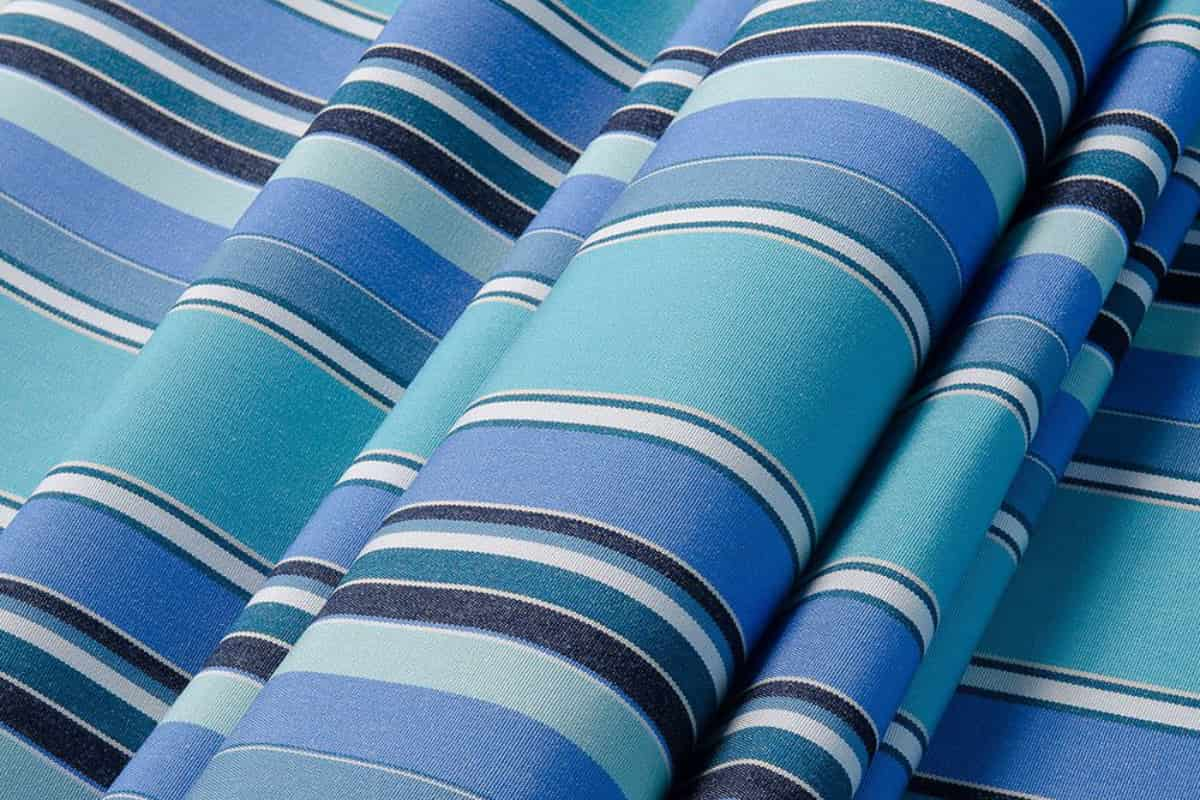
Acrylic Fabric
Outdoor fabrics made from acrylic fibers are strong and resistant to both weather and use damage. It’s mold and mildew resistant and can hold up against rubbing and tearing. This is especially important for outdoor upholstery in active residential and commercial applications. Acrylic fabrics are solution-dyed, which means that the threads are dyed before they are woven. This allows the textile to retain its color longer, even when exposed to direct sunlight. While it is water-resistant, acrylic fabric is more breathable than other options, allowing it to stay cooler in hot weather. It’s also easy to clean with mild soap and water. All things considered, acrylic fabric is best all-purpose textile for outdoor furniture cushions, throw pillows and patio umbrellas.
Sunbrella®
Sunbrella® is generally recognized as the “gold standard” of acrylic outdoor textiles. The company has products that range from soft and suitable for urban home use up to marine grade materials that can survive the rigors of saltwater, wind and sun on yachts and catamarans. You get what you pay for, and premium acrylic fabrics have a much higher price tag than other materials.
- PROS – Strong, durable, weather and moisture resistant, doesn’t fade and is easy to clean
- CONS – High cost
Olefin Fabric
Olefin is another solution-dyed synthetic fabric that is durable, quick-drying and fade-resistant. It stands up to mold, moisture and heat and is less expensive than acrylics. Olefin is lightweight and smooth, but it can lack the softness of some other textiles. It resists stains and abrasions and is easy to clean. It’s a great choice when acrylics are outside of your budget.
Etisilk – Texsilk®
Etisilk’s Texsilk® is one of the better-known brands of olefin outdoor garden and pool furniture fabric. It’s stain-resistant and strong enough to be cleaned by bleach or chlorine. Texsilk® is environmentally responsible and certified as a safe textile by OEKO-TEX.
- PROS – Durable, quick-drying, fade-resistant, easy maintenance and affordable
- CONS – Not as soft as alternative materials
Polyester Fabric
Read more : Coros Vertix 2 Review
This synthetic material is typically coated with either an acrylic or vinyl (PVC mesh) to protect it from the elements. Polyester is strong, flexible and resists water damage and staining. It’s tear-resistant and dries quickly, but most outdoor polyester fabrics (at least the non-treated average grade options) fade faster than other synthetic textiles. Unlike, solution-dyed alternatives, polyester hybrids are dipped in color or have the color painted on after the threads are woven. You can achieve brighter colors and more intricate patterns, but it won’t last as long when exposed to UV rays. Consequently, they do much better in shaded environments, when there is less direct sunlight.
Acrylic coated polyester works well for accents and pillows, while vinyl-coated polyester has a plastic-like feel that is better suited for self-supporting seat and back slings, screens, umbrellas and backing, where there is less skin contact. Two of the most renowned manufacturers of high-end PVC-coated polyester textiles are Ferrari and Twitchell.
Ferrari – Batyline® Mesh
Batyline® mesh is a premium synthetic outdoor fabric that is extremely strong and tear-resistant. Its open design allows airflow that helps the material stay cool and dry quickly. It is an ideal choice for self-supporting sling seating like poolside sunloungers, patio dining chairs and bar stools.
Twitchell – Textilene® Mesh
Textilene® mesh is similar to Batyline® in its applications. It’s used by many luxury outdoor furniture brands like Sifas for the seat and back slings of high-end lounge chairs and sofas. Twitchell also manufactures a variety of mesh grades that are appropriate for sun screens, awnings, tarps and fencing.
- PROS – Strong, resists tearing and water damage, quick drying and comes in bold colors and patterns
- CONS – Tends to fade fast than other fabrics
Core Foam
Cushions and accent pillows for outdoor furniture are only as good as the materials that go into them. At some point, they’re going to be exposed to rain, sleet, wet bathing suits or damp beach towels. Even if they have the most weather-resistant premium acrylic cover, some water will find its way in through seams and zippered closures. Consequently, the foam core of your upholstery must not only hold its shape and comfort level, but it must also be able to dry quickly and prevent damage from moisture too. Foam varies in quality, based on the material, production technique and treatment.
Open Cell Foam
Open-cell foam has pores that allow water and air to easily flow through it. It’s comfortable and cool, but more expensive than most alternatives. It is constructed with an antimicrobial agent that protects the foam from mold and mildew growth that can occur in the drying process.
Urecel – QuickDry® Foam
Urecel’s QuickDry® is the premium brand of open-cell foam. It is an advanced, high-performance foam that is specifically engineered for outdoor upholstery. QuickDry® is produced using a sophisticated process known as Hydro-Blast Reticulation, which makes the foam durable, strong and extremely comfortable. It also incorporates Uregard anti-microbial technology to keep it free from biological problems. QuickDry® is used by luxury outdoor furniture brands like Mamagreen and Cane-line.
- PROS – Quick-drying, comfortable and resists mold and mildew
- CONS – Expensive
Closed Cell Foam
Closed-cell foam (a.k.a. floatation foam) repels water and is buoyant, making it a good choice for boat seating and life vests. It can be made from a variety of plastics including neoprene, polypropylene, polyethylene and polystyrene. Each version has its own unique characteristics and applications. Spongy neoprene, for example, is flexible and provides thermal and moisture insulation for wet suits.
- PROS – Repels water, floats and variations have benefits for specific applications
- CONS – Expensive
Polyethylene Terephthalate (PET) Foam
PET foam inserts are durable, recyclable and provide optimum support for outdoor upholstery. They are firm and do not flatten out or lose their shape like some materials. PET dries quickly, preventing moisture build up that can lead to mildew and mold.
Dacron®
Dacron® is a leading brand of hypo-allergenic PET foam and it is often wrapped around other foams to provide an additional layer of protection.
- PROS – Durable, supportive, eco-friendly, quick-drying and resistant to mold and mildew
- CONS – Premium brands can be costly
Polyurethane Foam
This common affordable seating foam has a medium firmness and will soak up water if it gets wet. Most polyurethane foam is treated with a biocide that prevents fungus, mold and mildew from growing as the wet foam dries out. It’s often wrapped in plastic for extra protection before being inserted into an outdoor cover.
- PROS – Low price and resistant to biological issues
- CONS – Soaks up water, dries slowly and is more flammable
Polyester Foam
Compressed polyester is an inexpensive alternative to traditional foam. It dries relatively quickly and is easy to wash. It works best in low to moderate use outdoor environments, since it compresses over time and frequent use will cause it to lose shape quicker. Polyester fiberfill is another low-cost option that is machine washable and resistant to mildew. It is usually stuffed into an inner pre-sewn cover that is then covered in outdoor fabric. One drawback is that the loose fibers tend to bunch up during laundering and may need reshaping after heavy use.
- PROS – Inexpensive, dries relatively quickly and is easy to wash
- CONS – Loses its shape and usually require additional protective wrapping
Outdoor Furniture Materials Cheatsheet
To view a printable cheatsheet summary of many of the materials above, click here.
How do you clean and care for patio furniture?
The usable life of your outdoor furniture can be extended by keeping it clean and well-cared for during and after the Summer months. Each material has specific instructions for cleaning various types of spills, repairing damage and protecting it from the ravages of the wind, rain and sun. Read our Patio Furniture Cleaning & Care Guide for a detailed look at a variety of materials and tips for maintaining them.
Frequently Asked Questions – Outdoor Furniture Materials
References
- Ghorbani, M., Mahendran, A. R., van Herwijnen, H. W., Liebner, F., & Konnerth, J. (2018). Based laminates produced with kraft lignin-rich phenol-formaldehyde resoles meet requirements for outdoor usage. European Journal of Wood and Wood Products, 76(2), 481-487.
- Jankowska, A., Reder, M., & Gołofit, T. (2017). COMPARATIVE STUDY OF WOOD COLOR STABILITY USING ACCELERATED WEATHERING PROCESS AND INFRARED SPECTROSCOPY. WOOD RESEARCH, 62(4), 549-556.
- Mameng, S. H., Pettersson, R., & Leygraf, C. (2017). Effect of Stainless Steel Composition on Atmospheric Corrosion Resistance at a Marine Site in Dubai. Corrosion, 73(7), 880-891.
- Noh, N. I. F. M., & Ahmad, Z. (2017, November). Heat treatment on keruing and light red meranti: The effect of heat exposure at different levels of temperature on bending strength properties. In IOP Conference Series: Materials Science and Engineering (Vol. 271, No. 1, p. 012060). IOP Publishing.
- Topliff, C. R. (2018). USES AND INSTALLATION OF HDPE LINER TO REDUCE SOIL EROSION AND PREVENT WATER LOSS (Doctoral dissertation).
- Ali, A., & Ansari, A. A. (2013, April). Polymer Concrete as Innovative Material for Development of Sustainable Architecture. In 2nd International Conference on Emerging Trends in Engineering & Technology. College of Engineering, Teerthanker Mahaveer University (pp. 1-4).
Source: https://gardencourte.com
Categories: Outdoor

